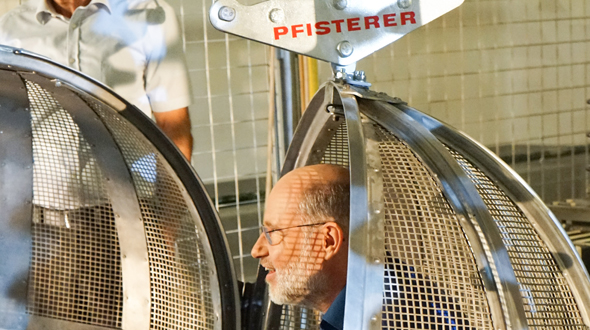Anyone who has been to the Deutsches Museum will be familiar with its high-voltage exhibit. The Faraday cage demonstration attracts around 200,000 visitors every year and is far and away the most popular demonstration at the Museum - an unforgettable experience for everyone who sees it. Bolts of lightning flash across the hall with a reverberating 'crack.' Three times daily, a member of the Museum staff climbs into the Faraday cage to prove that a metal cage can protect against electricity levels as high as 220,000 volts.
The high-voltage installation dates from the 1950s: the insulators of the Faraday cage had been in use for as long as 66 years, with the cage and museum employee hanging from them. The thousand-dollar question was: how long do such insulators actually last? An expert from the product testing service TÜV, who was to have assessed the installation recently, was unable to offer any conclusions on this point. Determined to exclude any risk, no matter how small, the Deutsches Museum experts therefore decided to replace the insulators. But where can you get hold of such specialised spare parts quickly? The Museum was naturally eager to avoid a long-term shutdown of its highlight.
Insulators sourced from Wunsiedel again - 66 years on
The original manufacturer of the insulators for the Faraday cage was Stemag, a company based in Wunsiedel, in Upper Franconia and a forerunner of the present-day LAPP Insulators GmbH. The company is still headquartered in Wunsiedel and retains its world-leading position as a manufacturer of insulators, just as it was all those years ago.
Once again, LAPP specialists produced the desired insulators and presented them to the Museum free of charge. "It's a real honour for us to be represented in the Deutsches Museum through our products," explains Jan Schulte-Fischedick, Head of Technical Consulting at LAPP Insulators. Deutsches Museum press spokesman Gerrit Faust adds, "We're absolutely thrilled to havethe highlight of our high-voltage installation up and running again."
Astrophysicist Harald Lesch in the Faraday cage
Incidentally, the refitted Faraday cage makes its first major TV appearance on ZDF at 7 p.m. on 7 October. On Harald Lesch's programme "Terra X - Fascination of the Universe, The Big Bang - Puzzle of the Beginning," the well-known astrophysicist, university lecturer and presenter will be getting into the cage himself.
Spectacular experiments in LAPP high-voltage laboratory
The high-voltage installation in the Deutsches Museum is a magnet for spectators, but Schulte-Fischedick refers to another highlight which is actually much older, though it still functions to the most modern standards. In Selb, near Wunsiedel, his company operates a high-voltage laboratory known as the Hochvolthaus. This started work in 1928 and still facilitates spectacular high-voltage experiments - though these are not open to the public. Both corona discharges (sometimes known as St. Elmo's fire) and brilliant brush discharges can be observed here. All this is on a slightly larger scale than the high-voltage installation at the Deutsches Museum: the laboratory can test at 1.3 million volts under dry conditions and in artificial rain, which the lightning generator can produce a massive 2.1 million volts.
